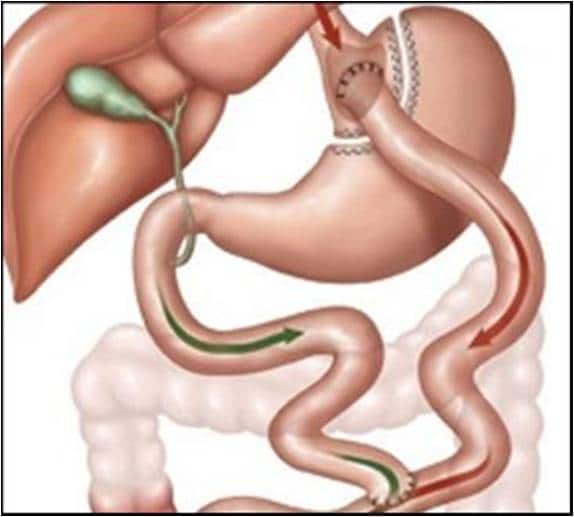Gastric Bypass
The Roux-en-Y gastric bypass has been the gold standard for surgical weight loss for many years in the United States.
In 1991, the National Institutes of Health first recommended Roux-en-Y gastric bypass surgery for patients who had a Body Mass Index (BMI) between 35 and 39.9 and suffered from any obesity-related health condition, or people who had a BMI of 40 or more, regardless of health.
The Procedure
In most cases, the procedure can be performed in about one hour. The procedure involves making five small incisions, each of which is approximately 1 cm in length. A small camera, called a laparoscope, is inserted into the abdomen, and the surgeon works to create a stomach pouch from the larger stomach body (aka stomach remnant). A portion of the small intestine is then connected to the stomach pouch, leaving a small opening for food to travel. This procedure results in a sensation of satiety or fullness after eating small meals, and patients generally continue to feel full with small portions over the course of their lifetime. Most patients stay in the hospital one to two nights, recover quickly, and return to normal activity within 1-2 weeks.
Roux-en-Y gastric bypass has been the most widely performed bariatric procedure in the United States for many years. Many long-term studies now demonstrate that the procedure is a durable and effective aid to long-term weight loss, health, and improved longevity. Most patients experience rapid weight loss immediately after surgery and continue to lose weight over the next 18 to 24 months. Most studies, and the extensive data at Western Bariatric Institute, show that over 95% of people succeed in significant weight loss and health improvement. Numerous studies indicate that heart problems, lung problems, diabetes, hypertension, obstructive sleep apnea and painful musculoskeletal problems improve in a high fraction of patients who have undergone Roux-en-Y gastric bypass.

Benefits
- It results in an average of 70% excess weight loss.
- More weight loss than Lap Band and slightly more than gastric sleeve.
- Reduces hunger.
- Does not require band adjustments like Lap Band surgery.
- Weight loss is rapid. The majority of weight loss occurs in the first year after surgery.
Complications
- Leak from the surgical staple line
- Higher risk of dumping syndrome unlike sleeve gastrectomy.
- Infection
- Bleeding
- Blood clots
- Nutritional deficiencies
- Gallstones
- Heartburn
After the Procedure
A gastric bypass alone is not a quick fix for obesity or obesity-related health conditions. A lifestyle change is necessary to enhance results. After weight loss surgery, it is imperative that you eat healthy foods, control portion sizes, and exercise. If you do not follow the regimen set for you, complications and unfavorable weight loss results can occur.